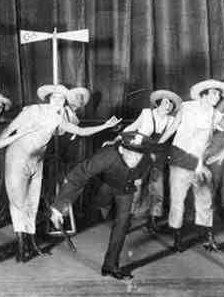YOUR DAILY DOSE OF EUBIE!!!
On May 3, 1922, the New York Clipper ran this notice about a new after-hours revue being staged at Reisenweber’s restaurant/cafe, a famous nightspot located on the edge of the theater district at 58th Street and Columbus Circle:
“BANDANALAND CLEVER SHOW. The invasion of Broadway cabarets by negro performers proves the sensational success of the all-colored show idea which was inaugurated last summer by the presentation of Shuffle Along at the Sixty-third Street Music Hall, where it will soon celebrate its first year. With the opening last week of a new colored show at Reisenweber’s there are now two elaborate negro shows for the amusement of the after-theatre and dinner parties on Broadway. Reisenweber’s new show is produced by Miller & Lyle and written by Sissle & Blake, producers of Shuffle Along. Most of the musical numbers are special, and some of them are remarkably good. The entertainment is called Bandanaland, and depicts a scene on a Mississippi levee. The entire room used is decorated in keeping with the entertainment, nothing being overlooked which might tend to put the patron in the mood of the show. The floor which is used by the performers and also the dancers is encircled by a number of piles which must have been taken right off the old Mississip’ itself, for they are encrusted with barnacles and similar marine growths. The platform where the colored orchestra plays is built up with rough boards, even the piano being enclosed in what looks like a packing case, all of which follows the general idea.

“The show itself is kept going from beginning to end at the speedy pace which marks the colored entertainer at all times. A number of the performers are also playing in Shuffle Along, including Lottie Gee, prima donna, and several others. Miss Gee is an exceptionally fine singer and has the added embellishment of a strikingly attractive personality. The first number is the singing of a roustabout song by the Palm Beach Four from Shuffle Along, which gives way to a chorus of eight chipper octoroons in Bandanaland. The eight girls are each and every one equipped with individual ability to entertain and get plenty of opportunity to do so throughout the show. May Brown and Garland Howard, two mighty presentable performers, lead this number. After another number by the quartette, the chorus aids W. H. Woodson, a good singer and dancer, in putting over the “Goofer Dust Blues,” an exceedingly clever lyric set to good music. Each of the chorus girls sings a verse about losing her sweetheart, strutting around in a circle in the meanwhile. This number is a real humdinger. Bob Williams and Charles Davis, the latter the policeman in Shuffle Along, do a song and dance in shipshape style, and Williams then plays a piano which is brought out on the floor. This number is about the only one which is slow. May Brown, in a nifty explorer’s costume, sings a number called “The African Boola Dance,” and the chorus illustrates. All of the girls are dressed in tiger skins and do as wild a dance as any jungle ever saw. Mildred Smallwood, a toe dancer who knows how to dance, comes in here and practically stopped the show. Lottie Gee sings two songs in her portion of the show and sings them to the edification of the most critical. The finale brings out the entire company, the girls dressed in brown cutaway suits, built for cakewalking. The number winds up in a fury of action and melody. The decorations for Bandanaland were executed by Charles Cadwalader, formerly art director for the Famous-Players-Lasky Corporation.”

Besides advertisements for the show in late April/early May in the New York newspapers, not much is known about it beyond this description. One notice noted that singer Gertrude Saunders—who had left Shuffle Along for a higher-paying gig—had joined the cast in mid-May at least temporarily for this revue. A “hula number” from the show was featured at a special charity event at the Hotel Astor on May 9th, in a variety show hosted by Eddie Cantor; Sissle, Blake, Miller, and Lyles also performed separately at this event. The songs mentioned in the Clipper’s notice were—as far as we know—unpublished or recorded at the time, although they may have been adaptations of earlier Sissle and Blake numbers or have been recorded or published under different names.
Earlier in 1922, members of the Shuffle Along cast had appeared at a special Jewish Relief Fund benefit hosted by Sophie Tucker at the restaurant in March. Later that month, the city sought to close the café for a year based on multiple violations of the Volstead Act—for selling liquor illegally during Prohibition. While the case worked its way through court, the club operated under a variety of names hosting different revues—including the “Paradise a la Russe Cafe” in early April and then as “The Bandana Room” for the presentation of Bandanaland. Advertisements for both revues boasted the line that the venue was “Formerly Reisenweber’s,” so few could have been fooled by this ruse—including the government. In July, an order was finally issued to close the restaurant for a year, but at the same time suspended for six months on the promise that liquor would no longer be sold there. However, by August there were charges lodged that champagne parties were being held at the “Paradise Café, formerly Reisenweber’s” in the press.